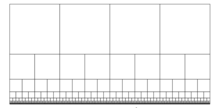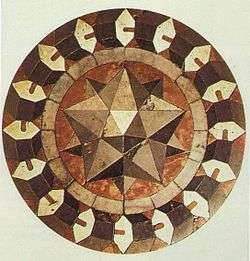Binary tiling
In geometry, the binary tiling (sometimes called the Böröczky tiling)[1] is a tiling of the hyperbolic plane, resembling a quadtree over the Poincaré half-plane model of the hyperbolic plane. It was first studied in 1974 by Károly Böröczky.[2][3][4]


Tiles
The tiles are shapes bounded by three horocyclic segments (two of which are part of the same horocycle), and two line segments. All tiles are congruent. Although they are modeled by squares or rectangles of the Poincaré model, the tiles have five sides rather than four, and are not hyperbolic polygons, because their horocyclic edges are not straight.[2] Alternatively, a combinatorially equivalent tiling uses hyperbolic pentagons that connect the same vertices in the same pattern. In this form of the tiling, the tiles do not appear as rectangles in the halfplane model, and the horocycles formed by sequences of edges are replaced by apeirogons.
Enumeration and aperiodicity
There are uncountably many different tilings of the hyperbolic plane by these tiles, even when they are modified by adding protrusions and indentations to force them to meet edge-to-edge. None of these different tilings are periodic (having a cocompact symmetry group),[2][5] although some (such as the one in which there exists a line that is completely covered by tile edges) have a one-dimensional infinite symmetry group.
Application
This tiling can be used to show that the hyperbolic plane has tilings by congruent tiles of arbitrarily small area.[3]
References
- Dolbilin, Nikolai; Frettlöh, Dirk. "Properties of Böröczky tilings in high-dimensional hyperbolic spaces" (PDF). European Journal of Combinatorics. 31 (4): 1181–1195. doi:10.1016/j.ejc.2009.11.016.
- Radin, Charles (2004). "Orbits of Orbs: Sphere Packing Meets Penrose Tilings" (PDF). American Mathematical Monthly. 111 (2): 137–149. doi:10.2307/4145214. JSTOR 4145214.
- Agol, Ian (January 26, 2018). "Smallest tile to tessellate the hyperbolic plane". MathOverflow.
- Böröczky, Károly (1974). "Gömbkitöltések állandó görbületű terekben I". Matematikai Lapok (in Hungarian). 25: 265–306. As cited by Radin.
- Penrose, R. (1979–1980). "Pentaplexity: a class of nonperiodic tilings of the plane". The Mathematical Intelligencer. 2 (1): 32–37. doi:10.1007/BF03024384. MR 0558670.
